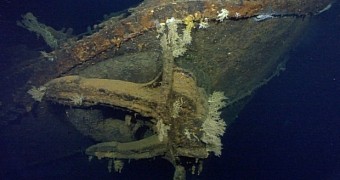This Wednesday, philanthropist, entrepreneur and Microsoft co-founder Paul G. Allen announced that, after having spent about 8 years looking for it, he and his team of underwater archaeologists had at long last found the remains of a WWII battleship.
The vessel, dubbed Musashi, counts itself among the biggest and the most technologically advanced ships ever to sail our planet's seas and oceans. In fact, this vessel and its sister, Yamato, are said to be the absolute heaviest and most heavily armed battleships ever built.
Unfortunately, neither of the two ships survived the war. Thus, the Yamato was sunk in April 1945. The Musashi, on the other hand, was lost in October 1944. Rumor has it that, to finally sink it, US forces had to fire 19 torpedoes and 17 bombs at it.
Then again, seeing how the Musashi weighed a whopping 73,000 tons and was protected by 18-inch (46-centimeter) armor plating, it really is a wonder that they managed to destroy it. One would think this vessel could've easily handled the Hulk himself.
The Musashi vessel now rests on the floor of the Sibuyan Sea
In a report detailing their work, Paul G. Allen and his team detail that it was just a few days ago that they found the wreckage of the Imperial Japanese Navy battleship Musashi. It is understood that the vessel now rests on the floor of the Sibuyan Sea in the Philippines.
As shown in the video below, whatever bits and pieces of this vessel broke apart when the ship got hit by the 19 torpedoes and the 17 bombs that ultimately led to its demise are surprisingly well preserved given the fact that they have spent decades underwater.
In fact, Paul G. Allen and the researchers working closely with him were able to accurately identify a valve wheel with writings inscribed on it, a catapult that served to launch planes, an anchor weighing 15 tones and even the imperial seal of Japan displayed on a teak chrysanthemum.
In case anyone was wondering, nobody has even the slightest intention to try and pull this battleship from the ocean floor. Instead, the Microsoft co-founder says that he plans to work closely with Japan's authorities to ensure that the site of the wreckage is properly preserved.
“Since my youth, I have been fascinated with World War II history, inspired by my father’s service in the U.S. Army. The Musashi is truly an engineering marvel and, as an engineer at heart, I have a deep appreciation for the technology and effort that went into its construction,” said Paul G. Allen.
Finding this long-lost WWII vessel was by no means child's play
To locate the Imperial Japanese Navy battleship Musashi at the bottom of the Sibuyan Sea, Paul G. Allen and his team first carried out a survey of the terrain, just to get an idea of what they were dealing with. They then zoomed in on the geographic features that looked most promising.
Just last month, the history enthusiasts decided to send an underwater autonomous vehicle nicknamed BlueFin-12 to have a closer look at the areas that they believed could hold the remains of the Musashi. On its third dive, the underwater autonomous vehicle successfully located the vessel's remains.
The exploration work that led to the discovery of the WWII battleship at the bottom of the Sibuyan Sea was carried out aboard Paul G. Allen's personal yacht, known as M/Y Octopus. Unlike other yachts, this technological wonder was especially designed to help with underwater research.
In fact, in was back in 2012 that the Microsoft co-founder and his M/Y Octopus worked together with the British Navy to explore the remains of the HMS Hood, another battleship that served the Royal Navy and that was blown up by German forces during WWII, in May 1941.

 14 DAY TRIAL //
14 DAY TRIAL // 